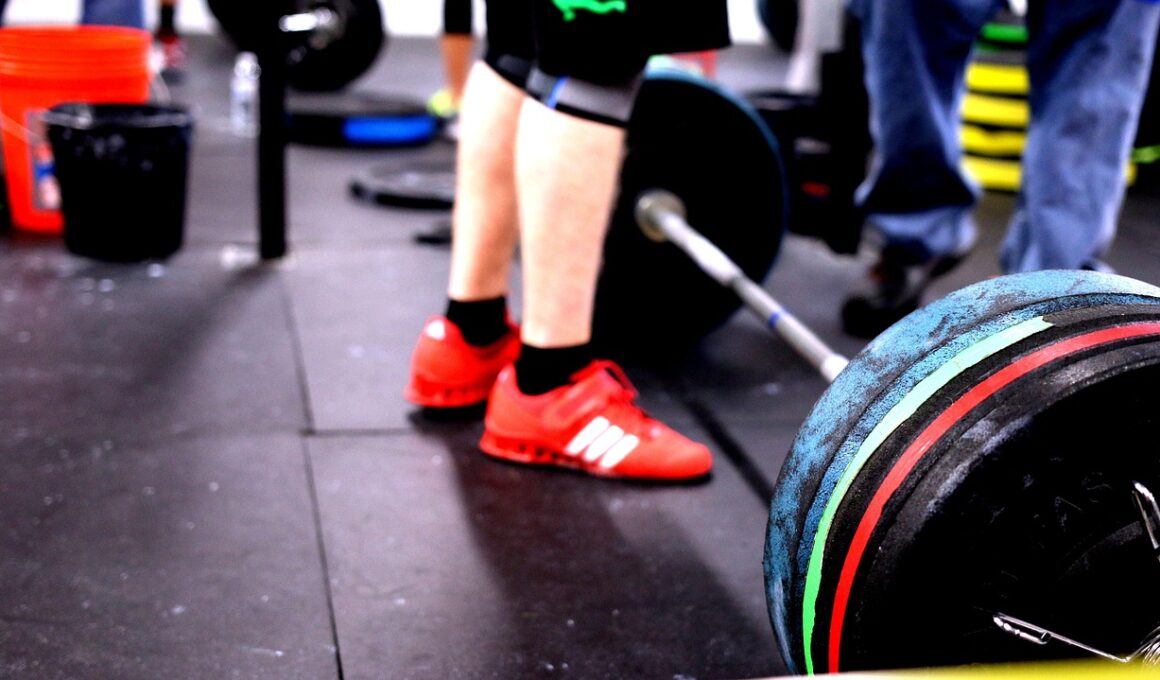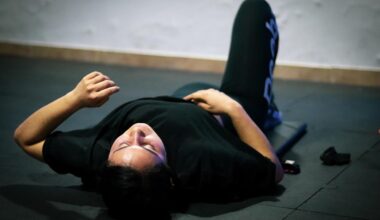Key Functional Movements Every Crossfit Athlete Should Master
Functional training plays a crucial role in enhancing a CrossFit athlete’s performance across various domains. The objective is to maximize strength, endurance, and agility through movements that mimic daily physical demands. One vital movement is the squat, which engages the lower body muscles, promoting balance and strength. It is imperative to perform squats with correct form to prevent injury and ensure effective strength development. Deadlifts also hold significant importance, as they are fundamental for core stability and overall strength gains. Proper technique should be emphasized as athletes must understand hip hinge mechanics to utilize this movement effectively. Furthermore, overhead presses play a critical part in developing shoulder stability and upper body strength. Regular practice of these functional movements not only enhances performance in CrossFit competitions but also improves day-to-day activities’ efficiency. Incorporating these exercises into a training regimen allows athletes to build a solid foundation. Additionally, they can translate strength gained in training into improvements in other workout modalities, creating a well-rounded fitness experience that fosters long-term progress. Ideal mastery of these movements results in increased confidence and performance during high-intensity workouts.
Another essential aspect to consider is the Pull Up, a staple in CrossFit workouts. This particular movement targets multiple upper body muscles, contributing to strength and grip development immensely. For CrossFit athletes, achieving multiple reps demonstrates not only strength but also muscular endurance. Implementing variations such as kipping pull-ups into training regimens is common. This helps athletes maximize force generation through hip movement, allowing for better overall performance in competitions. Likewise, the Clean & Jerk represents a comprehensive functional movement involving the entire body, promoting explosiveness and overall strength. Athletes should focus on proper mechanics to ensure effective power transfer from the legs through the core. Moreover, another critical movement to master is the Wall Ball Shot, connecting strength and cardiovascular endurance. It forces athletes to coordinate their movements while simultaneously building muscle. Accurate technique is necessary for optimizing performance and tackling challenges in various workouts. Furthermore, incorporating dynamic exercises like Box Jumps into training can enhance vertical leap and agility, which is essential for competitive success. All these elements combined create a formidable CrossFit athlete, equipped to handle diverse physical challenges with ease.
Core Functional Movements to Optimize Performance
Handstand Push-Ups are another key functional movement every CrossFit athlete should conquer. This movement develops shoulder strength, balance, and coordination while placing emphasis on core engagement. Mastering these push-ups allows athletes to control body positioning better and perform more advanced movements during workouts. Similarly, the Snatch movement promotes explosive power and muscular coordination. This technique requires emphasis on speed and precision, starting from the floor, and transitioning throughout the entire lift. Proper form is critical, with athletes needing to ensure their body alignment maintains efficiency. Lastly, Lunges are an indispensable functional movement in any CrossFit training program. They enhance lower body strength, balance, and flexibility, allowing athletes to improve their overall athletic performance. Different variations such as walking lunges or reverse lunges can be employed to target various muscle groups effectively. Engaging all these functional movements fosters improved biomechanics, consequently allowing CrossFit athletes to excel in competitions and daily tasks. Emphasis on quality over quantity during training ensures injury prevention while maximizing results. By focusing on these core movements, athletes build towards an all-around improved athletic capability.
Another movement that deserves attention is the Turkish Get-Up, which promotes flexibility and core strength through a unique sequence of movements. Athletes who master this exercise will notice enhanced stabilization and functional strength in daily activities. This movement also acts as a good integration of strength, balance, and coordination, offering a comprehensive training effect. Additionally, the use of kettlebells in various functional movements introduces an element of instability that engages stabilizer muscles effectively. When focusing on balance while executing exercises such as kettlebell swings, athletes gain not only muscle strength but also enhanced functionality. Flexibility is another important factor; thus, implementing stretching routines and mobility work post-exercises can improve overall performance. Recovery techniques such as foam rolling should not be overlooked in a functional training regimen as they assist in muscle recovery and injury prevention. All these factors play a critical role in a successful CrossFit program. Combining high-intensity workouts with an emphasis on functional movements paves the way for athletic success. CrossFit athletes who dedicate their training to these essential components will see a significant improvement in both their performance and overall well-being.
Importance of Structuring Your Training
As athletes implement these movements into their program, it’s critical to have a structured training plan. This ensures balanced progress and helps avoid burnout or overtraining. Integrating functional movements before high-intensity interval training (HIIT) can prepare the body for rigorous workouts. Initiating a session with skill work allows the athlete to focus on perfecting their reps. Either traditional strength training or bodyweight exercises should follow. This balanced approach develops muscular strength and endurance and fine-tunes technical skills. Additionally, monitoring progression is essential; athletes should track their performance metrics to ensure they are improving in each movement. Technology such as apps or workout journals can help streamline this process. Furthermore, the significance of cardiovascular conditioning should not be underestimated. Optimal conditioning combined with strength provides a well-rounded fitness profile that prepares the body adequately for the rigors of CrossFit. Inclusion of both aerobic and anaerobic exercises can also provide significant benefits. The result is a tailored and individualized training experience, enhancing the overall athletic ability to withstand the challenges faced in competitive environments.
CrossFit athletes also benefit from regularly revisiting their foundational movements as they progress in their training regimen. Assessing skills and strength means athletes can refine their techniques regularly. This focus on efficiency allows for improved performance in functional movements. Incorporating complex movements like muscle-ups into training can challenge athletes further while also promoting functional strength. Ensuring that flexibility and mobility work is consistent is vital for all athletes, as it can facilitate recovery and promote effective performance. Moreover, setting specific goals for each movement provides clarity and helps motivate athletes. Personal performance objectives coupled with short-term and long-term milestones encourage accountability and commitment. It’s essential to celebrate achievements, whether big or small, as this fosters a positive environment and keeps athletes engaged. Additionally, coming together in team training sessions reinforces camaraderie amongst athletes. Learning from one another encourages skill-sharing and creates opportunities for growth. Ultimately, approaching training with a comprehensive perspective will yield positive results. A well-rounded regimen encompassing technique, strength, and conditioning solidifies functional excellence essential for any successful CrossFit athlete.
Ultimately, the key to success for every CrossFit athlete lies in mastering these functional movements. The journey through conditioning, strength training, and skill applications can be fulfilling and rewarding. By emphasizing a variety of essential movements, athletes will improve their overall performance and broaden their fitness capabilities. Achieving proficiency in these exercises equips athletes to perform at a high level in diverse workouts. Their successful execution also contributes to improved biomechanics and performance enhancement. Establishing habits around these functional movements will yield results that are both sustainable and transformative. Furthermore, the importance of a supportive community cannot be underestimated. Surrounding athletes with like-minded individuals provides motivation and encouragement, further enhancing their journey. This environment fosters accountability, making it easier to stay committed to training goals. Together, athletes can push each other to attain personal bests, creating a cycle of improvement and achievement. The mastery of functional movements is not just about increasing performance; it’s about developing a resilient and adaptable approach to fitness. Through this dedication, athletes can achieve remarkable outcomes, leading to both personal satisfaction and athletic success.
In summary, the application of functional training principles is vital for every CrossFit athlete who aims to enhance their physical capabilities. Incorporating various movements, such as squats, deadlifts, and pull-ups, sets a solid foundation for improving performance. Focusing on the technical aspects of exercises facilitates strength gains while ensuring safe execution, mitigating injury risks. Engaging in diverse training modalities, including overhead presses and the Clean & Jerk, contributes positively to an athlete’s development. The combination of strength, flexibility, and agility exercises such as Handstand Push-Ups and lunges fosters comprehensive growth. Remaining diligent about recovery and mobility work is equally important for sustaining performance gains. Athletes should also embrace collective training sessions, as they reinforce skill-building and camaraderie. The roadmap to mastery involves setting individual goals and systematically progressing in training. The implementation of structured plans ensures balanced iterations in workouts, boosting overall endurance levels as well. In turn, this sustained commitment toward functional training compounds positive effects, leading to enhanced athletic success. As athletes master functional movements, they position themselves to excel not only in CrossFit but also in their daily lives, making an impact beyond the gym.


